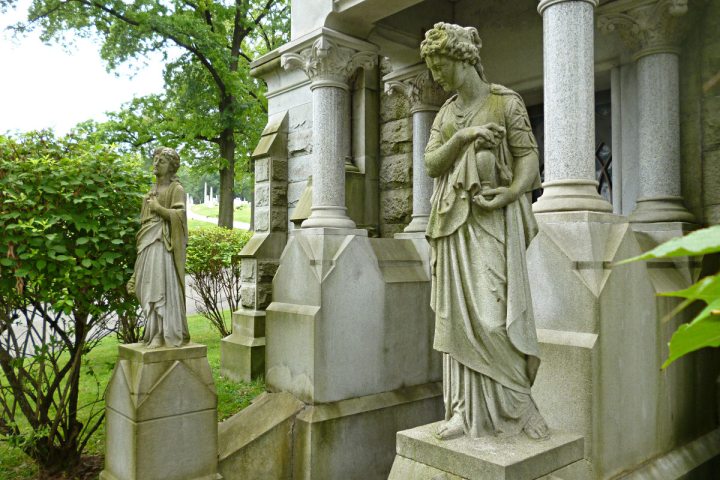In Pittsburgh the Egyptian style of architecture was briefly popular in the early twentieth century, almost always in association with death. The mausoleums in Egyptian style seem usually to belong to Masons, who trace their lodge and rituals back to the days of the Pharaohs, implausible as that may seem to Egyptologists. Some integrate Christian, Masonic, and Egyptian symbols rather uncomfortably.
We begin with the Hartley-Given mausoleum (1913).

This is a simple and straightforward interpretation of an Egyptian tomb, and we can see the elements that, in the Allegheny Cemetery, almost invariably mark the Egyptianness of the style: the sloping sides and the lotus columns. Over the entrance we usually find a winged scarab entwined by serpents—which Father Pitt believes is a Masonic symbol; perhaps a Mason will correct him if he is wrong.
Next, the Lockhart mausoleum (1903):
 Here is another typical Egyptian-tomb design, again with the requisite Egyptian signifiers; but in this one the porch projects from the structure instead of being inset.
Here is another typical Egyptian-tomb design, again with the requisite Egyptian signifiers; but in this one the porch projects from the structure instead of being inset.


The Sproal-Splane mausoleum (1917) is another variation on the same theme, with all the same elements and another inset porch:

Inside is a window that seems like a riot of symbols uneasily coexisting:

(The inscription around the cross and crown reads “IN HOC SIGNO VINCES.”)
All these are in reasonably good taste. But there is one Egyptian mausoleum that proudly flaunts its kitsch, one of the most extraordinary memorials in a cemetery full of extraordinary memorials:
 All the same elements are there, but the Winter mausoleum (1930)—whose colossal scale is hard to convey in a photograph—adds its own unique accessories. John Russell Pope, the famous beaux-arts architect, designed this mausoleum for banker Emil Winter—but “designed” is not really the right word here. The Woolworth mausoleum in Woodlawn, the Bronx, is nearly identical; Winter apparently saw it and told Pope “I want that,” and Pope gave it to him.
All the same elements are there, but the Winter mausoleum (1930)—whose colossal scale is hard to convey in a photograph—adds its own unique accessories. John Russell Pope, the famous beaux-arts architect, designed this mausoleum for banker Emil Winter—but “designed” is not really the right word here. The Woolworth mausoleum in Woodlawn, the Bronx, is nearly identical; Winter apparently saw it and told Pope “I want that,” and Pope gave it to him.
 Mr. Winter’s amazing sphinxes bear an expression that old Pa Pitt can only describe as “snooty.”
Mr. Winter’s amazing sphinxes bear an expression that old Pa Pitt can only describe as “snooty.”
 The bronze door depicts Mr. Winter himself, large as life and in full Pharaonic regalia, about to set off for his journey into the afterlife. Even this is identical to the bronze door of the Woolworth mausoleum, except for the substitution of Mr. Winter’s face.
The bronze door depicts Mr. Winter himself, large as life and in full Pharaonic regalia, about to set off for his journey into the afterlife. Even this is identical to the bronze door of the Woolworth mausoleum, except for the substitution of Mr. Winter’s face.
 Inside is a stained-glass window that reminds Father Pitt of cheap illustrated Sunday-school handouts, showing Mr. Winter properly enthroned. (It was devilishly hard to get a picture of this window, because the front doors are actually backed by a mesh screen. This was the best old Pa Pitt could do.)
Inside is a stained-glass window that reminds Father Pitt of cheap illustrated Sunday-school handouts, showing Mr. Winter properly enthroned. (It was devilishly hard to get a picture of this window, because the front doors are actually backed by a mesh screen. This was the best old Pa Pitt could do.)
Finally, as a coda to our little Egyptian tour, the Huhn monument is actually a pyramid.
 This is a pyramid of a curiously specific type: it is (if Father Pitt’s architectural history is correct, and he loves to be corrected when he is wrong) a Roman interpretation of the Egyptian pyramid, with proportions more like those of the Pyramid of Cestius along the Appian Way than like those of a true Egyptian pyramid. This also is a Mason’s tomb; if you enlarge the picture (by clicking on it), you can see the Masonic symbols at the base.
This is a pyramid of a curiously specific type: it is (if Father Pitt’s architectural history is correct, and he loves to be corrected when he is wrong) a Roman interpretation of the Egyptian pyramid, with proportions more like those of the Pyramid of Cestius along the Appian Way than like those of a true Egyptian pyramid. This also is a Mason’s tomb; if you enlarge the picture (by clicking on it), you can see the Masonic symbols at the base.






























